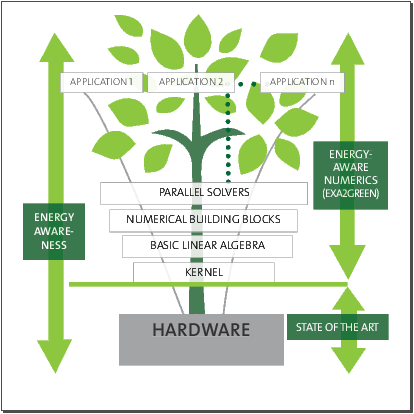Table of Contents
Exa2Green
Aims & Objective
In the second half of the 20th century, simulation has been established as the 'third pillar of scientific discovery', complementing theoretical analysis and experiment. The performance of High Performance Computing (HPC) hardware has since then increased rapidly, steadily driven by the ever-increasing demands for computing power in many areas of science. In 2008 the RoadRunner supercomputer was the first in breaking through the Petaflop barrier by delivering a performance of over 1 Petaflop/s = 10^15 floating point operations per second.
As the HPC community prepares for the upcoming Exascale age, it needs to face formidable challenges. The energy consumption of many HPC systems has reached a critical level, where the running costs for energy become equal to the acquisition costs for the hardware after only a few years. As of 2013, the most energy-efficient HPC systems deliver a performance of 2-3 Megaflops per Watt. An Exaflop system built using the same technology would require 300-500 Megawatts of power, which is completely unacceptable.
While it is widely recognized that advances in hardware design and manufacturing will lead to a significant increase of energy efficiency, it is less noticed that there is also much potential to reduce the energy consumption on the level of mathematical modeling and software engineering. This is the line of research pursued by the Exa2Green project. Its key aspect is that the issue of energy consumption and the resulting trade-off with the performance and the accuracy of the simulation will be taken into account in all simulation levels: from the kernel, numerical building blocks to the application level.

Research Topics
With different project partners from academia and industry, WR combines the competences and skills that are necessary to tackle the challenges related to energy-efficient high performance computing. The research is focused on the following topics:
- Design of tools for power monitoring and profiling.
- Development of new metrics for the quantitative analysis of the energy profile of algorithms.
- Implementation of energy-aware elementary kernels.
- Development of energy-efficient linear algebra libraries and linear solvers.
- Implementation of an energy-aware scheduling technology for HPC clusters.
- Optimization of the weather forecast software COSMO-ART for energy-efficiency in order to conduct a proof of concept for the methodologies and technologies developed in the Exa2Green project.
Funding
Exa2Green is a 3-year research project co-funded under the EU 7th Framework Program 'FET Proactive Initiative: Minimising Energy Consumption of Computing to the Limit'. FET (Future and Emerging Technologies) aims to go beyond the conventional boundaries of ICT and ventures into uncharted areas, often inspired by and in close collaboration with other scientific disciplines.
Partners
- Scientific Computing Group, Department of Informatics, Universität Hamburg, Germany
- IBM Research, Zürich, Switzerland
- High Performance Computing and Architectures group, Universitat Jaume I de Castellon, Spain
- Institute for Meteorology and Climate Research, Karlsruhe Institute of Technology, Germany
- Swiss National Supercomputing Centre / Swiss Federal Institute of Technology Zürich, Switzerland
People from WR
- Prof. Dr. Thomas Ludwig (contact person)
